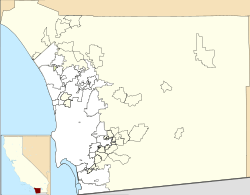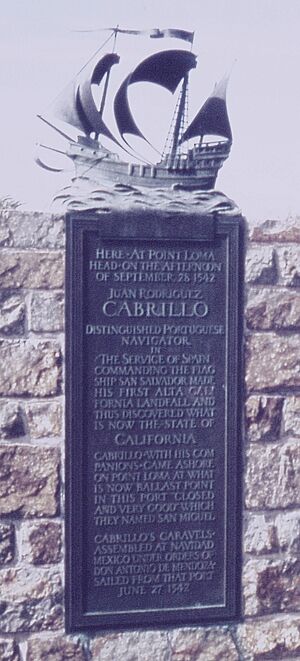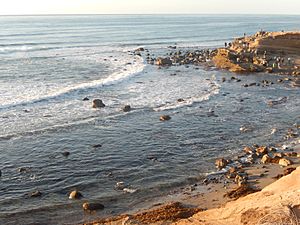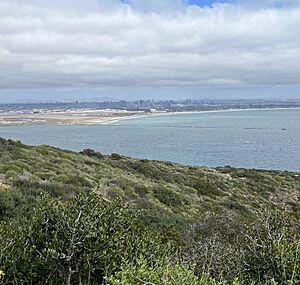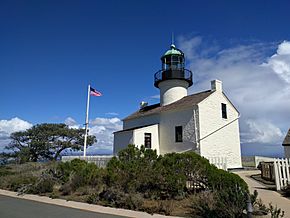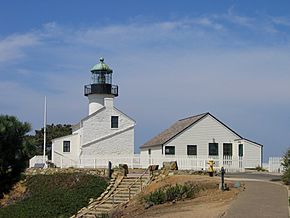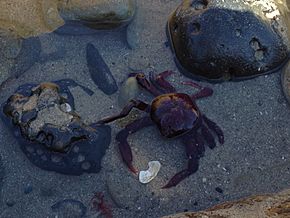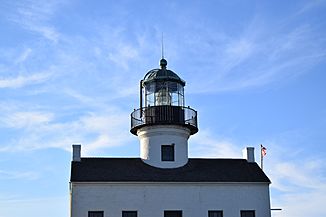Cabrillo National Monument facts for kids
|
Cabrillo National Monument
|
|
 |
|
| Nearest city | San Diego |
|---|---|
| Area | 143.9 acres (58.2 ha) |
| Built | 1949 |
| Architect | US Lighthouse Board; National Park Service |
| Architectural style | Late 19th And 20th Century Revivals |
| Visitation | 768,076 (2022) |
| Website | Cabrillo National Monument |
| NRHP reference No. | 66000224 |
Quick facts for kids Significant dates |
|
| Added to NRHP | October 15, 1966 |
| Designated NMON | October 14, 1913 |
Cabrillo National Monument is a special park in San Diego, California. It sits at the very tip of the Point Loma peninsula. This monument celebrates a big moment in history: the landing of Juan Rodríguez Cabrillo on September 28, 1542. He was the first European explorer to step onto what we now call the West Coast of the United States.
The park offers amazing views! You can see San Diego's busy harbor and tall buildings. You can also spot Coronado and the Naval Air Station North Island. On clear days, you might even see the vast Pacific Ocean, Tijuana, and Mexico's Coronado Islands.
Inside the park, a visitor center shows a film about Cabrillo's journey. It also has cool exhibits about his expedition.
The Old Point Loma Lighthouse is a famous landmark here. It has been a symbol of San Diego since 1855. The lighthouse stopped working in 1891 because fog often hid its light. A new lighthouse was built closer to the water. Today, the old lighthouse is a museum you can explore.
The monument also has old military buildings. These were once coastal artillery batteries. They helped protect San Diego's harbor from enemy ships. One building now has an exhibit about this military history.
Every year, the Cabrillo Festival Open House celebrates Cabrillo's landing. People even re-enact his arrival at Ballast Point. The festival also features Kumeyaay, Portuguese, and Mexican music and dance. You can find historical re-enactments and fun activities for kids.
Contents
Discovering Cabrillo National Monument's Past
The Cabrillo National Monument began with a small piece of land. On October 14, 1913, President Woodrow Wilson set aside about half an acre. The idea was to build a large statue of Juan Rodriguez Cabrillo.
For many years, different groups tried to build the statue. But it wasn't until 1939 that the Portuguese government helped. They ordered a huge statue of Cabrillo. It was 14 feet tall and weighed 14,000 pounds!
The statue had a long journey. It was meant for an event in San Francisco but arrived too late. It was stored in a garage for a while. Finally, in 1949, it found its home at Cabrillo Monument. The original sandstone statue wore down over time. In 1988, a new limestone replica replaced it.
Before the statue arrived, the area was used for gliding. From 1929 to 1935, pilots like William Hawley Bowlus set soaring records here. Even Charles Lindbergh flew a glider along these cliffs! You can find markers near the entrance that tell this story.
The monument was closed to the public during World War II. The entire southern tip of Point Loma was used for military purposes. After the war, presidents Eisenhower and Ford made the monument much larger. Today, it covers over 140 acres.
Amazing Animals and Plants at Cabrillo
Even with a big city nearby, Cabrillo National Monument is home to many plants and animals. The park works hard to protect these species.
Life in the Tide Pools
One of the most exciting places is the intertidal zone, or tide pools. When the tide is low, you can explore these rocky pools. They are full of amazing creatures!

You might see colorful anemones, tiny hermit crabs, and different kinds of sea urchins. There are also many types of snails, like periwinkles and top snails. Look for bright green sea lettuce and long feather boa kelp. The best time to visit the tide pools is in late fall or winter. That's when the tides are lowest during the day.
Whale Watching and Coastal Wildlife
In winter, from December to March, you can watch gray whales migrate. They swim past the coast from the Whale Overlook station. This was the first public whale-watching spot in the world, started in 1950!
The Bayside Trail offers a peaceful walk through coastal sage scrub habitat. This area is important for local wildlife.
Native and Non-Native Species Challenges
The park's environment faces challenges from non-native species. These are plants or animals that were not originally from the area. For example, Argentine ants have moved into the park. They have pushed out the native ants. This has caused problems for the coast horned lizard, which only eats native ants. In areas with Argentine ants, you won't find these lizards anymore.
Weather at Cabrillo National Monument
|
||||||||||||||||||||||||||||||||||||||||||||||||||||||||||||||||||||||||||||||||||||||||||||||||
The Point Loma Lighthouses
The Old Point Loma Lighthouse Story
In 1851, the U.S. Coastal Survey chose Point Loma for a lighthouse. Its high spot, 422 feet above sea level, seemed perfect. It could guide ships into the bay and along the coast.
Construction started in 1854 and finished in 1855. A special lens from France, called a Fresnel lens, was installed. On November 15, 1855, the keeper lit the oil lamp for the first time. On clear nights, its light could be seen 25 miles away!
However, the lighthouse's high location became a problem. Fog and low clouds often hid the light from ships. So, on March 23, 1891, the light was turned off for good. In 1984, the National Park Service lit it again for one night to celebrate its 130th birthday.
The New Point Loma Lighthouse
After the old lighthouse closed, a new one was built. It was placed at a lower spot on the hill. This new lighthouse is still active today! You can see its light from the Whale Overlook or the tide pool area.
Visiting the Park: What to Do!
The Visitor Center is a great place to start your adventure. You can buy souvenirs and learn more about the park's history. Park Rangers and volunteers are there to answer your questions. They can tell you about the weather, low tide times, and guided tours.
You can also get your National Park Passport stamped here. Check out the "Age of Exploration" exhibit. The auditorium shows films like "In Search of Cabrillo" and "First Breath: Gray Whales."
Kids can join the "Junior Ranger" program. By completing an activity sheet, you can earn a special Junior Ranger badge!
Fun Events Throughout the Year
Cabrillo National Monument hosts many exciting events. Sometimes, there are "Fee Free Weekends" when everyone can enter for free.
"Whale Watch Weekend" happens in January. Experts lead walks and talks as guests look for migrating Pacific Gray Whales. "Founder's Day" on August 25 celebrates the start of the National Park Service. "Open Tower Day" on November 15 marks the anniversary of the Old Point Loma Lighthouse. On these two days, the lighthouse tower, usually closed, is open to visitors!
You can also explore a restored World War II bunker. It's open to the public on the fourth Saturday of each month.
Gallery
- Cabrillo National Monument
See also
 In Spanish: Monumento nacional Cabrillo para niños
In Spanish: Monumento nacional Cabrillo para niños



